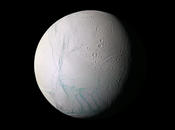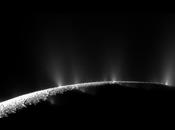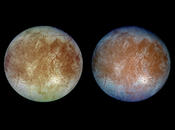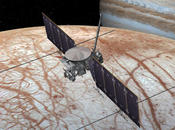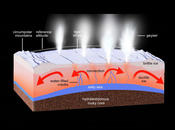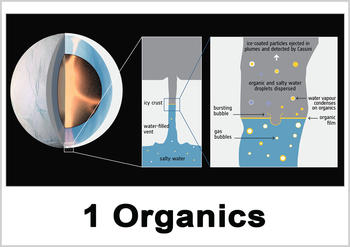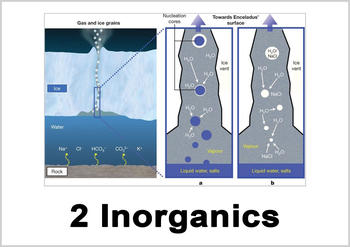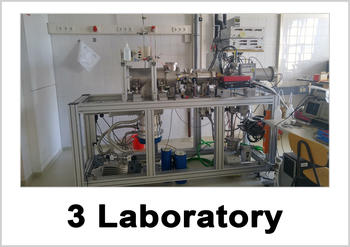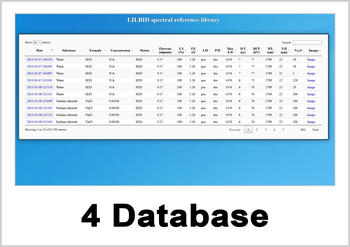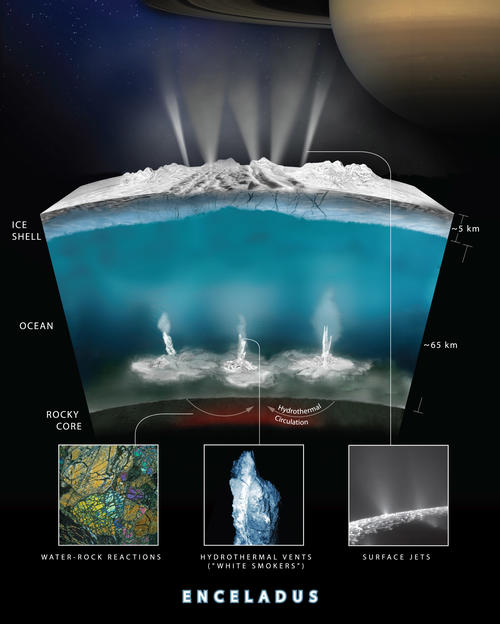Department of Earth Sciences
Service Navigation
Habitat-OASIS – Habitability of Oceans and Aqueous Systems on Icy Satellites
Habitat-OASIS addresses the question of habitability of the outer solar system by looking at spacecraft data and preparing for future space missions using novel approaches. The classical view held that for a planet or moon to be habitable requires liquid water at or near its surface. This view has been challenged by the discovery of numerous subsurface oceans below the icy crusts of moons orbiting Jupiter and Saturn. The amount of water detected there is several times higher than on Earth and it is kept liquid primarily by tidal heating rather than solar heating. In particular, the cryo-volcanic moons Enceladus and Europa, orbiting Saturn and Jupiter respectively, are considered to have the largest astrobiological potential. On these two moons, the ocean floor is in contact with a rocky core and there are indications for hydrothermal activity - hot water flowing out from the rocky sea floor into the ocean. On Earth, these kinds of hydrothermal vents are places where life developed independently of sunlight.
On Enceladus (and probably also on Europa), active plumes expel ice grains carrying matter previously dissolved and suspended in the subsurface oceans, allowing their geochemistry to be investigated and constrained. The mass spectrometers aboard the Cassini-Huygens spacecraft, in orbit around Saturn until September 2017, analyzed this material and have already delivered spectacular science results. Project 1 of this proposal is a refined data analysis of the Enceladus plume material using novel techniques and is the first ever opportunity to explore in detail a potential ocean habitat outside Earth. Newly developed laser-assisted dispersion experiments are used to acquire mass spectra of a wide variety of analogue materials, enabling the identification and quantification of inorganic, organic and possibly biogenic compounds embedded in the ice grains. Geochemical aqueous alteration experiments and numerical modelling help to further constrain the habitability of Enceladus and extrapolate the results to other ocean moons. Project 2 will leverage the laboratory capabilities from Project 1 to create a comprehensive library of mass spectra in preparation for the upcoming missions visiting Jupiter’s icy moons: ESA’s JUICE Mission and NASA’s Europa Clipper Mission. Having analogue measurements available early in the missions will be critical for exploiting their full potential.
The different aspects of Habitat-OASIS:
ERC-funded Publications
- Matteioni, P. et al. (2025), Topographical analysis of Libya Linea on Europa: Geologic evolution and identification of a new putative cryovolcanic or diapir field. JGR: Planets 130, DOWNLOAD PDF
- Napoleoni et al. (2024), Probing the Oxidation State of Ocean Worlds with SUDA: Fe (II) and Fe (III) in Ice
Grains, DOWNLOAD PDF -
Christophe Malaterre et al. (2023), Is There Such a Thing as a Biosignature? Astrobiology 23, doi: 10.1089/ast.2023.0042, DOWNLOAD PDF
-
Napoleoni et al. (2023), Mass Spectrometric Fingerprints of Organic Compounds in SulfateRich Ice Grains: Implications for Europa Clipper. ACS Earth & space chemistry (b), DOWNLOAD PDF & SUPPLEMENTARY MATERIAL
-
Matteoni, P. et al. (2023), Evolution of Thrace Macula on Europa: Strike-slip tectonic control and identification of the youngest terrains. JGR: Planets 128, DOWNLOAD PDF
-
Matteoni. P. et al. (2023), Ménec Fossae on Europa: A strike-slip tectonics origin above a possible shallow water reservoir. JGR: Planets 128, DOWNLOAD PDF
-
Postberg, F. et al. (2023), Detection of phosphates originating from Enceladus’s ocean. Nature, Vol. 618, https://doi.org/10.1038/s41586-023-05987-9, DOWNLOAD PDF
-
Napoleoni et al. (2023), Mass Spectrometric Fingerprints of Organic Compounds in NaCl-Rich Ice Grains from Europa and Enceladus. ACS Earth & space chemistry (a), DOWNLOAD PDF & SUPPLEMENTARY MATERIAL
-
Spesyvyi, A. et al. (2023), Charged Ice Particle Beams with Selected Narrow Mass and Kinetic Energy Distributions, J. Am. Soc. Mass Spectrom., 34, 5, 878–892, DOWNLOAD PDF
-
Sanderink, A. et al. (2023), OLYMPIA-LILBID: A New Laboratory Setup to Calibrate Spaceborne Hypervelocity Ice Grain Detectors Using High-Resolution Mass Spectrometry, Amal. Chem., 95, 7, 3621 - 3628, DOWNLOAD PDF
-
N. Khawaja et al. (2023), Discriminating Aromatic Parent Compounds and Their Derivative Isomers in Ice Grains From Enceladus and Europa Using a Laboratory Analogue for Spaceborne Mass Spectrometers, Earth and Space Science (ESS), DOWNLOAD PDF
-
Dannenmann, M. et al. (2023), Toward Detecting Biosignatures of DNA, Lipids and Metabolic Intermediates from Bacteria in Ice Grains Emitted by Enceladus and Europa. Astrobiology 23. DOWNLOAD PDF
-
Mousis, O. et at. (2022), Moonraker: Enceladus Multiple Flyby Mission, Planet. Sci. J. 3, 268, DOWNLOAD PDF
-
Khawaja N. et al (2022), Complementary Mass Spectral Analysis of Isomeric O-bearing Organic Compounds and Fragmentation Differences through Analog Techniques for Spaceborne Mass Spectrometers. The Planetary Science Journal, DOWNLOAD PDF
-
Hao, J. et al. (2022), Abundant phosphorous expected for life in Enceladus’s ocean, PNAS 119, No. 39, DOWNLOAD PDF
-
Klenner, F. et al. (2022), Developing a Laser Induced Liquid Beam Ion Desorption Spectral Database as Reference for Spaceborne Mass Spectrometers, Earth and Space Science, 9 (9). DOWNLOAD PDF
-
MacKenzie, S. M. et al. (2021), The Enceladus Orbilander Mission Concept: Balancing Return and Resources in the Search for Life, The Planetary Science Journal, 2:77 (18pp), https://doi.org/10.3847/PSJ/abe4da.
-
Cable, M. L. et al. (2021), The Science Case for a Return to Enceladus, The Planetary Science Journal, 2:132 (12pp), https://doi.org/10.3847/PSJ/abfb7a.
-
Choblet, G. et al. (2021), Enceladus as a potential oasis for life: Science goals and investigations for future explorations, Exp Astron, https://doi.org/10.1007/s10686-021-09808-7.
-
Mitri, G. et al. (2021), Exploration of Enceladus and Titan: investigating ocean worlds’ evolution and habitability in the Saturn system, Exp Astron, https://doi.org/10.1007/s10686-021-09772-2.
-
Soderlund, K. M. et al. (2020), Ice-Ocean Exchange Processes in the Jovian and Saturnian Satellites, Space Sci Rev 216, 80 (2020), doi: 10.1007/s11214-020-00706-6. DOWNLOAD PDF
-
Dachwald, B. et al. (2020), Key Technologies and Instrumentation for Subsurface Exploration of Ocean Worlds, Space Sci Rev (2020) 216:83, doi: 10.1007/s11214-020-00707-5. DOWNLOAD PDF
-
Klenner, F. et al. (2020), Discriminating Abiotic and Biotic Fingerprints of Amino Acids and Fatty Acids in Ice Grains Relevant to Ocean Worlds, Astrobiology 20 (10), 1168-1184. doi:10.1089/ast.2019.2188. DOWNLOAD PDF
-
Klenner, F. et al. (2020), Analog Experiments for the Identification of Trace Biosignatures in Ice Grains from Extraterrestrial Ocean Worlds, Astrobiology 20 (2), doi:10.1089/ast.2019.2065. DOWNLOAD PDF
-
Taubner, R.-S. et al. (2020), Experimental and Simulation Efforts in the Astrobiological Exploration of Exooceans, Space Sci Rev, 216(1), 1531, doi:10.1007/s11214-020-0635-5. DOWNLOAD PDF
-
Sterken, V.J. et al. (2019), Interstellar Dust in the Solar System, Space Sci Rev, Vol. 215, Issue 7, 1797, doi:10.1007/s11214-019-0607-9.
-
Klenner, F. et al. (2019), Analogue Spectra for Impact Ionization Mass Spectra of Water Ice Grains Obtained at Different Impact Speeds in Space, Rapid Commun Mass Spectrom, Vol. 33, Issue 22, pp. 1751–1760, doi:10.1002/rcm.8518. DOWNLOAD PDF
-
Khawaja, N. et al. (2019), Low-mass nitrogen-, oxygen-bearing, and aromatic compounds in Enceladean ice grains, MNRAS, Vol. 489, Issue 4, pp. 5231–5243, doi:10.1093/mnras/stz2280. DOWNLOAD PDF
-
Burrati, B. J. et al. (2019), Close Cassini Flybys of Saturn's ring moons Pan, Daphins, Atlas, Pandora, and Epimetheus, Science, Vol. 364, Issue 6445, doi:10.1126/science.aat2349. DOWNLOAD PDF
-
Postberg, F. et al. (2018a), Macromolecular Organic Compounds from the Depths of Enceladus, Nature, Vol. 558, pp. 564-568. DOWNLOAD PDF
-
Postberg, F. et al. (2018b), Plume and Surface Composition of Enceladus, In: Enceladus and the Icy Moons of Saturn, University of Arizona Press, pp. 129-162. DOWNLOAD PDF
-
Glein, C.R., Postberg, F., and Vance, S. (2018), The Geochemistry of Enceladus: Composition and Controls, In: Enceladus and the Icy Moons of Saturn, University of Arizona Press, pp. 39-56. DOWNLOAD PDF
-
Hsu, H.-W. et al. (2018), In situ collection of dust grains falling from Saturn’s rings into its atmosphere, Science, Vol. 362, 6410. DOWNLOAD PDF
PARTICIPANTS FUNDED BY THE PROJECT
- Prof. Dr. Frank Postberg
- Dr. Jon Hillier
- Dr. Nozair Khawaja
- Dr. Fabian Klenner
- Pietro Matteoni
- Maryse Napoleoni
- Lenz Nölle
- Arnaud Sanderink
- Muhammad Umair
- Zenghui Zou
COLLABORATORS
• Laboratory for Planetologie and Geodynamik (LPG), Univ. of Nantes
• Laboratory for Atmospheric and Space Physics (LASP), Univ. of Colorado, Boulder
• Jet Propulsion Laboratory (JPL), Caltech, Pasadena
• Institut für Raumfahrtsysteme (IRS), Univ. of Stuttgart
• Leibniz Institut für Oberflächensysteme (IOM) Leipzig
• Laboratoire de Physique et Chimie de l'Environnement et de l'Espace (LPCE), Univ. of Orleans
• Open University Astrobiology Research Group, The Open Univ., Milton Keynes
• Astronomy Research Unit, University of Oulu (Finland)
FINANCIAL SUPPORT • PROJECT FUNDING
• Project ID: 724908
• Funded by the European Union
• European Research Council (ERC)
ERC-2016-COG Consolidator Grant
• Term: Feb 01, 2017 - Apr 30, 2023
